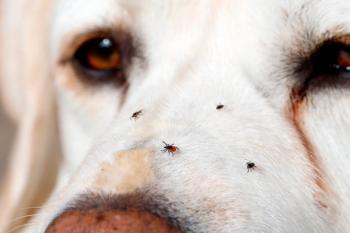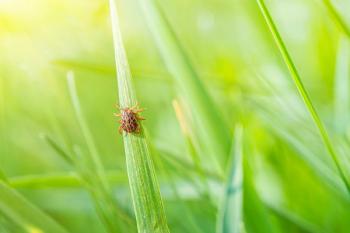
All about coccidian (Proceedings)
Coccidia are obligate intracellular parasites and have asexual and sexual stages in their life cycle.
Coccidia are obligate intracellular parasites and have asexual and sexual stages in their life cycle. Eimeria spp. have a direct life cycle and ingested sporulated oocyst reproduce in respective organs including liver, kidney, and mainly intestines. Through the process of multiple rounds of asexual reproduction will produce large number of merozoites. Following the last round of merizoite replication, the merizoites will differentiate into male and female stages to begin sexual reproduction. Once fertilization occurs feces. The processes of both asexual and sexual reproduction result in rupture of the infected cells and associated disease as a result of epithelial destruction.
The life cycle of Atoxoplasma, a coccidian parasite that infects birds, also has a direct life cycle with both asexual and sexual life stages. The asexual reproduction occurs in the intestines of infected birds and also in mononuclear phagocytes of the gut mucosa, resulting in infected mononuclear cells containing the merozoite that may stay in the gut or enter the blood to disseminate the parasite to other extraintestinal tissues such as the liver. Sexual reproduction occurs in the intestines and results in the excretion of oocysts in the feces.
Toxoplasma gondii and Isospora are different in that they have a direct life cycle but can utilize a paratenic host. The only definitive host for Toxoplasma is the cat. Thus, sexual reproduction (the formation of micro and macrogamonts) and shedding of oocysts occurs only the gastrointestinal tract of felids. Oocysts that are shed in the feces of cats will sporulate to become infective to nearly any warm-blooded vertebrate host. Any warm-blooded animal that consumes the oocyst may act as a paratenic host – i.e., the parasite can live in the tissues of the paratenic host but the parasite does not require growth or multiplication in the paratenic host in order to complete its life cycle. When the cat or paratenic host ingests the infective oocyst, the sporozoites are released and undergo massive asexual reproduction in the cells of the intestines and lymph nodes producing tachyzoites. These tachyzoites continue to multiply in other cells of the body (extraintestinal phase); destruction of infected cells is what results in disease and signs of disease will depend upon the organ infected (i.e., pneumonia if damage occurs in lungs, neurologic signs if damage occurs in brain). After the fast replicating tachyzoite stage, a slow replicating bradyzoite stage will begin in which the parasite forms cysts, containing the bradyzoites, in various tissues that can include the brain. The cysts will persist for the life of the animal. If a cat ingests a parentic host that has the encysted bradyzoites, the bradyzoites will enter the small intestinal epitheial cells and first undergo asexual reproduction and then the sexual reproductive life stage, shedding oocysts 3-10 days later. If the life cycle is direct, and the cat ingests sporulated oocysts (rather than the encysted bradyzoites of a paratenic host), it take 19-48 days to shed oocysts which suggests that the parasite can accomplish much of the required asexual reproductive stages in the process of forming bradyzoites in the paratenic host.
Isospora may undergo direct transmission or indirect transmission by use of a paratenic host. A rodent or bird may act as a paratenic host by ingesting the sporulated oocyst. In the paratenic host, the sporozoite is released from the oocyst and migrates to lymph nodes where it will encyst (monozoic cyst) and be infective to the carnivore that consumes the rodent. The host may consume the infected paratenic host or ingest the sporulated oocysts from the environment. There is no extraintestinal life cycle for this coccidian and both asexual and sexual reproduction occurs in the villar epithelium and nonsporulated oocysts are excreted in the feces. However, extraintestinal migration of the parasite may occur in the host after ingestion of the sporozoites in the host. Some sporozoites may enter the mesenteric lymph node (as also seen in the paratenic hosts) or may enter other extraintestinal tissues (spleen, liver) where they form cysts. Thus, monozoic cysts may form in both the definitive and paratenic hosts and remain for the life of the animal. In definitive hosts, the cyst may rupture and release sporozoites to reinfect the intestine.
The advantage of having an asexual life stage for these coccidian parasites is the ability for the parasite to rapidly and markedly increase the number of parasites from the ingestion of only a single sporozoite. Asexual reproduction allows the parasite to quickly and exponentially increase in a non-immune host. In theory one ingested oocyst can produce close to a 1million new oocysts in feces of naïve animal depending on age and available intestinal cells to infect.
Most (although not all) coccidian parasites undergo sexual reproduction in the gut. This is an important strategy for transmission because oocysts are therefore shed in the feces for a feco-oral transmission. Infection can result in clinical signs as a result of cellular destruction (the severity of disease seen is related to the degree of infection and cellular destruction). Diarrhea will increase the environmental contamination, which can aid in transmission especially in a captive environment. Although coccidiosis may cause morbidity and/or mortality, it would not be advantageous to the parasite to cause high degree of mortality thus the asexual reproduction ceases after a genetically predetermined number of cycles (which may vary per coccidian species).
Parasitic encystment (either as encysted bradyzoites in Toxoplasma or as monozoic cysts in the paratenic or definitive hosts for Isospora) is another strategy for the parasite for transmission or reinfection. The use of a paratenic host by Isospora and Toxoplasma is an advantageous because it increases the chance of exposure to the definitive host by “presenting” the parasite back to the definitive host. By infecting prey species (and affecting the prey species such that it is more susceptible to predation as is seen in Toxoplasma infection of rodents) the parasite increases its chances of returning to the felid host to complete the sexual stage of the life cycle. For wild felids with large home-ranges and solitary behavior, the ingestion of a paratenic host may be more likely than ingestion of infective oocysts directly.
Many, if not all, animals have been reported with one or more coccidian parasites, but infection does not typically cause disease in free-ranging wild animals in natural conditions. Clinical coccidiosis is seen in captive animals because transmission is enhanced by captive conditions. Because there is no requirement for an intermediate host, these parasites with a direct life cycle are easily transmitted in captive environments. Environmental contamination in a closed/confined space is much greater than over a natural habitat and the controlled temperature and humidity of captive animal holding can promote sporulation of the oocyst to its infective form. The oocysts can be destroyed by desiccation and direct sunlight but many commonly used disinfectants are not effective and thus a captive environment can be easily contaminated. Captive animals are also typically found at much higher density than wild animals, increasing the chance for shedding and exposure. In breeding or production facilities there are young animals that have not yet developed immunity to the parasite and are susceptible to infection clinical disease and likely to shed the parasite. Coccidian oocysts may be shed from asymptomatic animals as well (there have been reports of 30-50% prevalence in apparently healthy animals of a range of species) thus environmental contamination and risk for reinfection is high in a captive environment. Lastly, stress is a known factor in the development of clinical coccidiosis. “Winter coccidiosis” in cattle occurs likely due to the stress of extreme temperatures in combination with infection, while outbreaks of clinical coccidiosis have been seen after shipping (another stressful event) in other species. Sources of stress in captive animals can include high stocking density, poor nutrition, competition, and handling that could contribute to the development of clinical coccidiosis. While wild animals also have stressors, they do not have the added combination of high levels of environmental contamination, high stocking density, and intensive breeding or production.
The most pathogenic lesions in enteric coccidiosis occur as a result of the host cell rupture during the asexual propagation. Most coccidia develop in villus enterocytes but others may develop in crypt enterocytes or lamina propria. Rupture of the host cell at the end of merogony is associated with the release of schizonts (containing merozoites). Cell rupture also occurs when the oocyst is released after the sexual reproduction stage. Destruction of enterocytes or lamina propria results in diarrhea, dehydration, weight loss, and severe hemorrhage.
Antiprotozoal vaccines for animals include vaccines against coccidiosis for poultry, many of which are actually nonattenuated oocysts from various coccidian species. Anticoccidial treatment is often used at the time of vaccine administration. Interestingly, use of live coccidia vaccines in poultry houses can restore a drug-sensitive population of parasites to populations in which drug-resistant coccidia become prevalent. Live coccidiosis vaccines that incorporate attenuated oocysts and a nonliving subunit vaccine are also available.
Anticoccidial compounds generally fall into one of two categories. The first are polyether ionophores which disrupt the proper intra and extracellular concentrations of the various cations and leads to cellular dysfunction. The second group includes compounds that cause an enzymatic reaction. The various classes of anticoccidial compounds and their mechanism of action are listed below.
Polyether Ionophores fall into one of five categories including monovalent, monovalent glycosides, divalent, divalent glycosides, and divalent pyrole ethers. Their mode of actions is to form lipophilic complexes with alkali metal cations and to transport these ions across biological membranes. The end result is that the cell is unable to maintain the proper intra and extracellular concentrations of the various cations and leads to cellular dysfunction. A main way this occurs is by the Ionophores interfering with the K+/Na+ pump osmolarity. Ionophore drugs also allow some cycling of the coccidia in the bird which aids in producing immunity. Ionophores generally have lower rate of resistance development compared to the enzyme reaction drugs listed above and often allow some low level cycling of the coccidia in the host leading to host immunity. Anticoccidial drugs belonging to the polyether Ionophores include lasalocid, salinomycin, maduramicin, monensin, narasin, lonomycin, and semduramicin. Maxiban is toxic in turkeys and should not be used in this species, but is a safe drug for quail, pheasants and chickens
Enzyme or metabolic blocking anticoccidial compounds include sulfonamides are folate antagonists and their mechanism of action (MOA) occurs by competitive inhibitors of PABA in the dihydropteroate synethetase reaction to make folate. Normally, folate is reduced to tetrahydrofolate, using NADPH as a co-factor, and is used to create and methylate DNA. 2,4-diaminopyrimidines act in a similar fashion and block the reduction of folate to tetrahydrofolate. The combination of sulfonamides and 2,4-diaminopyrimidines is synergistic and is active on first and second generation schizonts and perhaps sexual stages as well. Amprolium is a thiamine antagonist and acts by competitively inhibiting the active transport of thiamine. Care must be taken not overdose animals on amprolium or secondary complications including polioencephalomalacia may develop due to lack of thiamine.
Coccidia are generally immunogenic and a single infection in an immunocompenent host will induce immunity to reinfection to some degree. However, exceptions to this generality have been noted. Immunity in coccidia occurs primarily as a result of the asexual replication, with the sexual stages contributing little additional protection. Immunity to a challenge inoculum is manifested as a reduction in clinical signs and reduced multiplication of the parasite. Circulating antibodies are effective at opsonization and cytopathological and enhancing the uptake of parasites of macrophages. The role of cell-mediated immunity has been shown to be the most important factor in host protection. Adoptive transfer of lymphocytes from Eimeria immunized animals to naïve animals leads to protection when challenged. It is assumed that the importance of cell mediated immunity is the same in all vertebrate hosts of coccidia.
Newsletter
From exam room tips to practice management insights, get trusted veterinary news delivered straight to your inbox—subscribe to dvm360.






